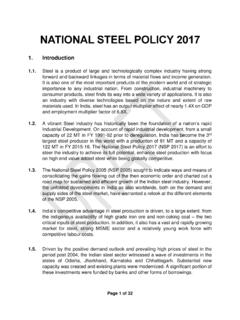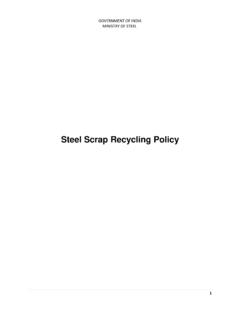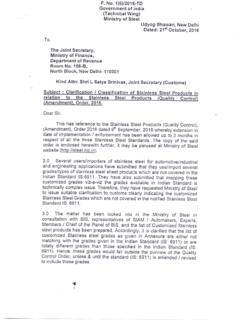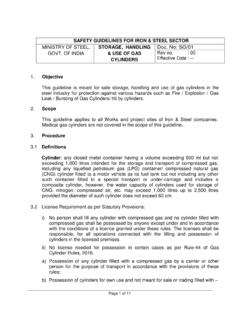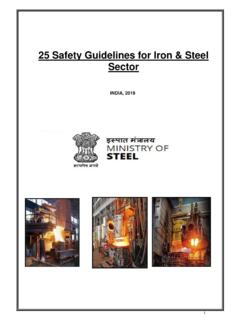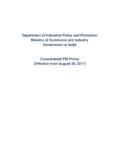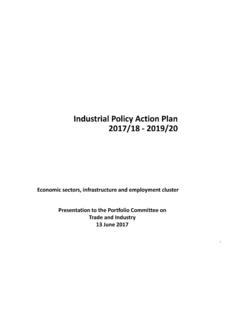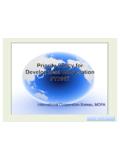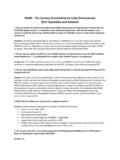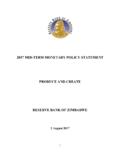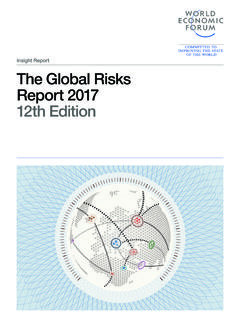Transcription of NATIONAL STEEL POLICY 2017 - Ministry of Steel | …
1 Page 1 of 31 NATIONAL STEEL POLICY 2017 1. Introduction STEEL is a product of large and technologically complex industry having strong forward and backward linkages in terms of material flows and income generation. It is also one of the most important products of the modern world and of strategic importance to any industrial nation. From construction, industrial machinery to consumer products, STEEL finds its way into a wide variety of applications. It is also an industry with diverse technologies based on the nature and extent of raw materials used. In India, STEEL has an output multiplier effect of nearly on GDP and employment multiplier factor of A vibrant STEEL industry has historically been the foundation of a nation s rapid Industrial Development.
2 On account of rapid industrial development, from a small capacity of 22 MT in FY 1991-92 prior to deregulation, India has become the 3rd largest STEEL producer in the world with a production of 90 MT and a capacity of 122 MT in FY 2015-16. Today, the Indian STEEL industry contributes approximately 2% to the country s GDP and employs about 5 lakh people directly and about 20 lakh people indirectly1. The NATIONAL STEEL POLICY 2017 (NSP 2017 ) is an effort to steer the industry to achieve its full potential, enhance STEEL production with focus on high end value added STEEL while being globally competitive.
3 The NATIONAL STEEL POLICY 2005 (NSP 2005) sought to indicate ways and means of consolidating the gains flowing out of the then economic order and charted out a road map for sustained and efficient growth of the Indian STEEL industry. However, the unfolded developments in India as also worldwide, both on the demand and supply sides of the STEEL market, have warranted a relook at the different elements of the NSP 2005. India s competitive advantage in STEEL production is driven, to a large extent, from the indigenous availability of high grade iron ore and non-coking coal the two critical inputs of STEEL production.
4 In addition, it also has a vast and rapidly growing market for STEEL , strong MSME sector and a relatively young work force with competitive labour costs. Driven by the positive demand outlook and prevailing high prices of STEEL in the period post 2004, the Indian STEEL sector witnessed a wave of investments in the 1 As per the MECON Estimates Page 2 of 31 states of Odisha, Jharkhand, Karnataka and Chhattisgarh. Substantial new capacity was created and existing plants were modernized. A significant portion of these investments were funded by banks and other forms of borrowings.
5 India became the 3rd largest producer of STEEL in 2015 and is now well on track to emerge as the 2nd largest producer after China. There is significant potential for growth given the low per capita STEEL consumption of 61 Kg in India, as compared to world average of 208 Kg. Indian economy is rapidly growing with enormous focus on infrastructure and construction sector. Several initiatives mainly, affordable housing, expansion of railway networks, development of domestic shipbuilding industry, opening up of defence sector for private participation, and the anticipated growth in the automobile sector, are expected to create significant demand for STEEL in the country.
6 Further, while the main focus of the industry is on the domestic market, being in close vicinity of the developed west and developing east, provides it a strategic location that augurs well for the industry seeking opportunities for exports of finished goods and imports of some scarcely available raw materials. The Indian STEEL industry is structured in between three broad categories based on route wise production viz. BF-BOF, EAF and IF. BF-BOF route producers have large integrated STEEL making facilities which utilize iron ore and coking coal for production of STEEL .
7 Unlike other large STEEL producers, the Indian STEEL industry is also characterized by the presence of a large number of small STEEL producers who utilize sponge iron, melting scrap and non-coking coal (EAF/IF route) for steelmaking. As on March 2016, there were 308 sponge iron producers that use iron ore/ pellets and non-coking coal/gas providing feedstock for STEEL production; 47 electric arc furnaces & 1128 induction furnaces that use sponge iron and/or melting scrap to produce semi-finished STEEL and 1392 re-rollers that rolls out semi-finished STEEL into finished STEEL products for consumer end use.
8 Page 3 of 31 Figure 1: Current STEEL footprint in India Source: Ministry of STEEL , JPC Over the past two decades, the Indian STEEL industry has developed capabilities of producing a wide range of value added STEEL at par with global best practices addressing diverse needs of the end user industries. However, India still needs to make a special effort to domestically produce number of value added products like automotive STEEL for high end applications, electrical STEEL (CRGO), special STEEL and alloys for Power equipment, Aerospace, Defense and Nuclear applications. However, the Indian STEEL sector is disadvantaged due to limited availability of some of the essential raw material such as high grade lumpy Manganese ore & Chromite, coking coal, STEEL grade limestone, refractory raw material, Nickel, Ferrous Scrap etc.
9 Due to shortage of domestic coking coal, both in terms of quantity and quality, pig iron producers/ BF operators in India have to significantly depend on import of coking coal. In the recent past, multiple issues have also adversely impacted the STEEL sector, viz. cancellations of iron ore and coal mine allocations, delays in land acquisition, environmental clearances, which led to many of the projects facing significant cost and time overruns. Additionally, companies also faced substantially increased operating costs on account of increased logistics & raw material costs and other charges.
10 Page 4 of 31 Post 2011, global prices of STEEL began to decline, marking the beginning of a down turn in the global STEEL industry triggered by slowdown in global demand and over capacities in a number of countries including China. By July 2015, prices had fallen by 50% compared to January 2011 - their lowest in decades, as cheap imports flooded world STEEL markets. This significant structural asymmetry between demand and supply also affected large number of Indian companies leading to surge in imports resulting in weak pricing conditions, low profitability, lower capacity utilization and even closure of capacities in some cases.
